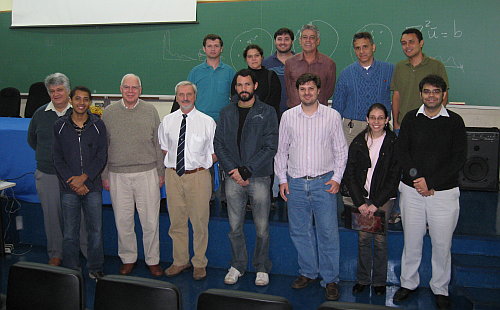Professor Carlos A Brebbia, Director of Wessex Institute of Technology, visited UNICAMP (University of Campinas, Brazil) at the invitation of Professor Leandro Palermo, Head of the School of Civil Engineering.
The objective of the visit was to strengthen links between the two institutions and exchange research ideas in topics of common interest. The visit included a series of discussions with the Heads of different departments and research groups, including Agricultural Engineering, Hydraulics Laboratory, Structures, Petroleum and Chemical Engineering. The outcome was a series of possible initiatives that will be studied by both Institutions.
During the visit, Carlos gave a few presentations and two main lectures. The first dealt with the basic mathematical concepts behind the Boundary Element Method and its historical perspective, explaining how the Southampton group gave origin to the definition and terminology of the method. During the lecture, Carlos classified the different alternatives for Mesh Reduction Methods and dealt with the fundamental problem of how to transfer internal effects to the boundary. The review pointed out the differences between techniques and their advantages and disadvantages. The lecture was enhanced by comments about the main scientists involved and their contribution to the development of modern BEM.

Carlos also paid tribute to the work of his main mentors in his BEM research. He mentioned his first mentor Prof Nestor Distefano (latterly of the University of California at Berkeley) who made him aware of the work of the Italian School as related to the Volterra’s integral equations, which were used at that time to model concrete creep. Prof Eric Reissner of MIT and University of California at San Diego, opened up to him the new possibilities of mixed formulations, the computer implementation of which Carlos pursued under Prof Jerry Connor also of MIT. An important influence on Carlos’ development was Professor Hugh Tottenham, his PhD supervisor at the University of Southampton, who made him aware of the Russian School of integral equations. These were the basis for Carlos’ development of the Boundary Element Method.
Carlos’ other lecture dealt with industrial applications of BEM, based on the work at Wessex Institute of Technology. Carlos started by explaining WIT’s aims and the way in which it carries out is knowledge transfer activities, describing in detail its research divisions, training programmes, academic publishing and technical support and consulting. He presented some interesting examples and described case studies. He concluded by showing photographs of the facilities at WIT and in particular those related to researchers, PhD students and visitors.
During the visit, Carlos discussed research topics with the number of staff and students and have ample opportunity to visit different laboratories.
The success of the visit will help to strengthen the links between the two institutions.

 Wessex Institute
Wessex Institute